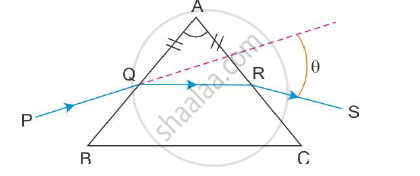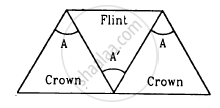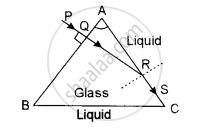Advertisements
Advertisements
प्रश्न
When a ray of white light is incident obliquely on the first surface of a prism, then ______.
पर्याय
Red colour is deviated most.
Green colour is deviated most.
Yellow colour is deviated most.
Violet colour is deviated most.
उत्तर
When a ray of white light is incident obliquely on the first surface of a prism, then violet colour is deviated most.
Explanation:
Shorter wave lengths (like violet) deviate more in a prism due to increased refraction, whereas longer wavelengths (like red) deviate least. The deviation of light in a prism is dependent on its wavelength.
APPEARS IN
संबंधित प्रश्न
Plot a graph to show the variation of the angle of deviation as a function of the angle of incidence for light passing through a prism. Derive an expression for the refractive index of the prism in terms of angle of minimum deviation and angle of the prism.
A ray PQ incident on the refracting face BA is refracted in the prism BAC as shown in the figure and emerges from the other refracting face AC as RS such that AQ = AR. If the angle of prism A = 60° and refractive index of material of prism is `sqrt3 `. Calculate angle θ.

What is a dispersion of light
State any two difference between the primary rainbow and secondary rainbow
If three identical prisms are combined, is it possible to pass a beam that emerges undeviated? Undispersed?
Three thin prisms are combined as shown in figure. The refractive indices of the crown glass for red, yellow and violet rays are μr, μy and μv respectively and those for the flint glass are μ'r, μ'y and μ'v respectively. Find the ratio A'/A for which (a) there is no net angular dispersion, and (b) there is no net deviation in the yellow ray.

The refractive index of a material M1 changes by 0.014 and that of another material M2 changes by 0.024 as the colour of the light is changed from red to violet. Two thin prisms, one made of M1(A = 5.3°) and the other made of M2(A = 3.7°) are combined with their refracting angles oppositely directed. (a) Find the angular dispersion produced by the combination. (b) The prisms are now combined with their refracting angles similarly directed. Find the angular dispersion produced by the combination.
A narrow beam of monochromatic light, PQ, is incident normally on one face of an equiangular glass prism of refractive index 1.45. When the prism is immersed in a certain liquid, the ray makes a grazing emergence along the other face (See figure). Find the refractive index of this liquid. 
Define angular dispersion.
Prove that in case of a prism, i + e = A + δ, where the symbols have their usual meanings.
